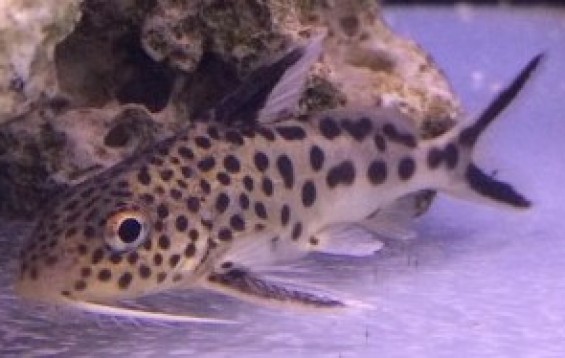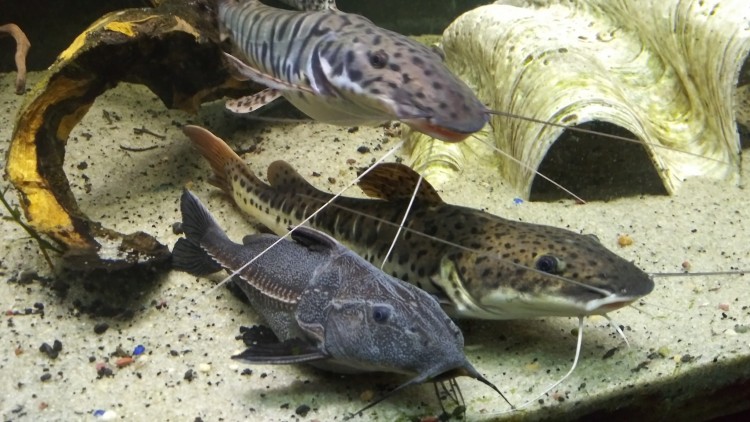- Name:
Synodontis Multipunctatus Catfish
(View AKA's) - Family: Mochokidae
- Species: Catfish
- Scientific Name: Synodontis multipunctatus


General info about Synodontis Multipunctatus Catfish
The average adult in captivity is 6 inches. It seems there are two varieties in the wild; one is considered the “northern tribe” which is beige with dark spots over its body and the other one is the “southern tribe” which is paler and has more spacing between the spots, both varieties get darker with age. This species can produce sound when its feeling threatened by rubbing the base of the pectoral spine against the pectoral girdle. The ideal aquarium for these catfish should have water temperatures ranging from 77ºF to 78.8ºF; it should be dimly lit and have plenty of hiding places like driftwood, bogwood, and caves but also have areas of open water for swimming. It is a schooling species, so it is best to be kept in groups of at least 3, it can be kept as a single individual, but the individual will spend most of its time hidden in a cave. It can be kept in a community aquarium as long as its tankmates are large fish, any smaller fish present may be seen as prey.
Synodontis Multipunctatus Catfish Diet & Nutrition
This species is omnivorous. In the wild, it mainly eats small invertebrates. In an aquarium, it can be fed with dried, live and frozen foods as well as vegetable matter, like shelled peas.
Determining Sex of Synodontis Multipunctatus Catfish
Mature females are rounder than males while males have a higher dorsal fin than females.
Breeding & Spawning Synodontis Multipunctatus Catfish
S.multipunctatus has an unusual spawning behavior; it utilizes mouth-brooding Cichlids as foster parents for their fry. As soon as a Cichlid egg is dropped, this catfish eats it and drop its eggs; the female Cichlid will then try to pick up as many eggs as she can, this will include the catfish’s eggs, and will incubate them along with her eggs. S. multipuntactatus fry hatch before the cichlids and will feed on them.
Unlike other Synodontis, this species is often bred in captivity. To do this, a host species must be chosen, and then both sets of fish should be put on a varied diet of live and frozen food. As soon as the Cichlids begin to breed, the catfish pair will mate as well. When the Cichlids begin to spawn, the catfish will quickly eat the Cichlids eggs and lay its own. Once the Cichlids have finished spawning, the female will pick up the eggs including the catfish’s eggs. The catfish’s eggs will hatch before the Cichlids’s and will feed on them. The adult catfish should be separated once the female Cichlid has picked up the eggs in her mouth. It is not recommended to use Tanganyikan Cichlids since there is no record of a successful spawning with them as hosts, it is thought that these Cichlids have evolved to avoid S. multipunctatus. There are records of breeding in aquariums without resorting to parasitism; it seems this species can also spawn openly like other Synos.
Synodontis Multipunctatus Catfish Origin
This species is endemic to Lake Tanganyika, Africa.
Caution with Synodontis Multipunctatus Catfish
It is important to maintain weekly water changes and efficient filtration since these fish produce a lot of biological waste.
Original Detail
| Name | Species | Family | Scientific Name | More Detail | Added by |
|---|---|---|---|---|---|
| Synodontis Multipunctatus Catfish | Catfish | Mochokidae | Synodontis multipunctatus | The average adult in captivity is 6 inches. It seems there are two varieties in the wild; one is considered the “northern tribe” which is beige with dark spots over its body and the other one is the “southern tribe” which is paler and has more spacing between the spots, both varieties get darker with age. This species can produce sound when its feeling threatened by rubbing the base of the pectoral spine against the pectoral girdle. The ideal aquarium for these catfish should have water temperatures ranging from 77ºF to 78.8ºF; it should be dimly lit and have plenty of hiding places like driftwood, bogwood, and caves but also have areas of open water for swimming. It is a schooling species, so it is best to be kept in groups of at least 3, it can be kept as a single individual, but the individual will spend most of its time hidden in a cave. It can be kept in a community aquarium as long as its tankmates are large fish, any smaller fish present may be seen as prey. |
PalaciosAn |



